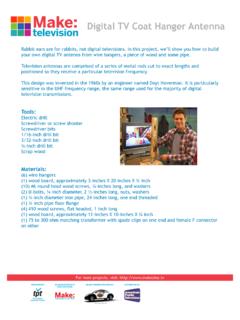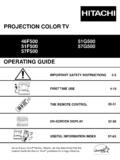Transcription of Designing and installing outdoor TV antenna - …
1 Design and Installation of outdoor TV antenna Schmidt Consulting Tom Schmidt Revised 11/30/2017 Originated 11/12/2008 Summary Digital television (DTV) transition June 12, 2009 motivated me to review our outdoor TV antenna and undertake an upgrade program during the fall of 2008. We live in a fringe area able to receive both Boston and NH stations. Boston stations are 42 miles away; nearest NH station only 13. This paper documents the steps we took to evaluate our options, install a new outdoor antenna and our experience over the years. In the 2019-2020 timeframe over-the air (OTA) broadcasting will undergo another significant transition. The FCC station repack plan changes the over-the-air landscape by once again reducing the number of TV channels and requiring many stations move to a different frequency or shut down.
2 On the technology front the transition from ATSC to ATSC digital broadcast standard will allow broadcasters to offer higher resolution programs and integrate broadcast TV with the internet. OTA TV had fallen out of favor with the rising popularity of cable and satellite providers but is experiencing somewhat of a renaissance. About 20% of American households currently rely exclusively on over-the-air TV and a significant number of cable and satellite subscribers use OTA for one or more TVs. There is much talk of cutting the cord, folks that have canceled cable and satellite TV. DTV dramatically improves video and audio quality while allowing multiple programs to fit into the same RF bandwidth previously occupied by a single analog program. Many stations now offer one or more standard definition (SDTV) channels as well as a main program in high definition (HDTV).
3 Quality is often better than cable or satellite because channels are not recompressed (transcoded) to fit available capacity. With ATSC broadcasters will be able to offer 4k UHD. 2 Background We live in southern NH. This gives us access to both NH and Boston stations. Being 42 miles from Boston in hilly forested New England requires a high gain outdoor rooftop antenna . Our existing outdoor antenna was over 20 years old so the digital transition motivated me to see if anything could be done to improve reception. The old system consisted of separate VHF and UHF antennas mounted on west gable with a mast-mounted preamp. A rotor positions the antenna between NH and Boston stations. A separate omnidirectional antenna was used for FM. TV and FM signals were carried over separate coax cables to outlets throughout the house.
4 Design goal: Receive more stations Minimize or eliminate need for rotor Integrate FM distribution so all TV outlets have FM capability Improve antenna grounding First off there is no such thing as a digital TV antenna , that is marketing hype. An antenna does not care if it is receiving an analog or digital program. Its purpose is to capture an electric field and deliver it to the receiver. That being said DTV reception is more demanding then analog. Analog slowly degrades as noise increases showing up as snow. DTV is subject to cliff effect. Reception remains perfect until signal falls below a critical threshold. When that occurs the receiver is no longer able to recover the signal. Longley-Rice propagation modeling is used to predict TV coverage area. During the transition planning phase FCC and stations worked together to engineer desired coverage.
5 Modeling criteria has been criticized for producing overly optimistic results. Real world DTV coverage tends to be worse than predicted due to cliff effect in rural areas and multipath interference in urban locations. Whereas with analog the viewer decides how much snow/ghosting to tolerate before deeming a program unwatchable with DTV it is the receiver that makes the determination, reception is either perfect or nothing. Digital TV, like analog, is affected by multipath. Ideally the signal traveled over a single path from transmitter to receiver. In the real world TV signals bounce off buildings, airplanes, mountains etcetera. Reflected signals are delayed relative to main signal. With analog NTSC TV multipath results in ghosting. Digital ATSC tuners used to be very susceptible to multipath.
6 Newer designs do a better job rejecting multipath but if extreme will still corrupt signal. Fringe TV reception consists of two main components: an outdoor antenna to capture weak signal and a preamp to boost signal to compensate for distribution losses between antenna and TV. The system must have enough gain to receive weak distant signals while not being overloaded by nearby transmitters. In order to receive the extremely weak fringe signals the antenna needs high gain, but the down side is beam width becomes very narrow requiring accurate pointing. Rural viewers often have stations at wildly divergent compass headings. To deliver an acceptable signal antenna must be precisely aligned to each station. The most common way to achieve this 3 is by using a rotator. The rotor is able to position the antenna to any desired compass heading.
7 The downside is only subsets of desired stations are available at any given antenna position. This is a serious problem for homes with multiple TVs or DVRs. Cost and convenience must be factored in. antenna height is normally dictated by structure used to mount antenna . It is possible to erect a tower to provide greater elevation but that is usually not feasible due to cost and aesthetic considerations. antenna grounding is critical for safety. A properly grounded antenna bleeds off static charge caused by wind passing over the antenna . It also goes a long way to reducing damage caused by nearby lightning strikes. Interested readers are strongly encouraged to visit Ken Nist s HDTV primer site, particularly the antenna section. Much of the information in this paper was derived from Ken s site.
8 Over the air TV broadcast In the US the FCC standardized on the NTSC format in 1941 but widespread commercial broadcast did not occur until after WWII. NTSC is analog as were subsequent color and stereo audio enhancements. Digital transmission offers many advantages and 2009 saw the conversion from analog to digital transmission. We are currently in another transition period as the result auctioning off more TV channels and the deployment of the next generation digital standard ATSC Broadcast TV uses two frequency bands. Channels 2-13 are Very high frequency (VHF) and 14-51 are Ultra high frequency (UHF). VHF TV channels are further split into two blocks, channels 2-6 (VHF low) and 7-13 (VHF High). VHF low is not ideal for DTV due to man-made noise and propagation characteristics.
9 In most markets there are no digital VHF low stations. TV channel allocation In the aftermath of the digital TV transition UHF Channels 52-69 are no longer designated for TV broadcast in the United States. They have been auctioned off for other purposes. This is not the first time broadcast TV lost channels. Channel 1 went away back in the 1940 s and channels 70-83 were lost in the 1980 s. Channel 37 is reserved for radio astronomy. In some urban areas channels 14-20 are used for two-way radio rather than TV. Over the next few years the number of TV channels will be reduced once again as a result of the FCC incentive auction. Going forward there are now a maximum of 35 (2-36) TV channels a drastic reduction from the original 82 VHF/UHF channels. 4 Channel Band Notes 1 VHF-lo 1948 reassigned public safety land mobile 2-6 VHF-lo TV poor choice for DTV 7-13 VHF-hi TV 14-20 UHF TV not available in some urban areas 21-36 UHF TV 37 UHF Reserved for radio astronomy 38-50 UHF 2017 reassigned cellular 51 UHF 2011 removed due to cellular interference 52-69 UHF 2009 DTV transition, reassigned cellular 70-83 UHF 1983 reassigned land mobile Digital TV (DTV) vs high definition television (HDTV) Digital TV (DTV) refers to the way program is transmitted.
10 The Advanced Television System Committee (ATSC) standard replaced the older National Television System Committee (NTSC) analog system. Digital TV and high definition TV (HDTV) are often confused. Just because a program is digital does not mean it is high definition. DTV is capable of broadcasting HDTV or a combination of HDTV and standard definition TV (SDTV). Digital transmission is spectrally and temporally more efficient than analog making it possible to deliver not only higher quality but multiple programs, called sub channels. A TV channel that in the past was limited to a single analog program is now able to deliver multiple programs. Each station choses which combination of HD and SD programs to broadcast. ATSC ups the ante enabling transmission of 4K Ultra HD. Virtual channel numbers A source of confusion is the notion of virtual channels.




